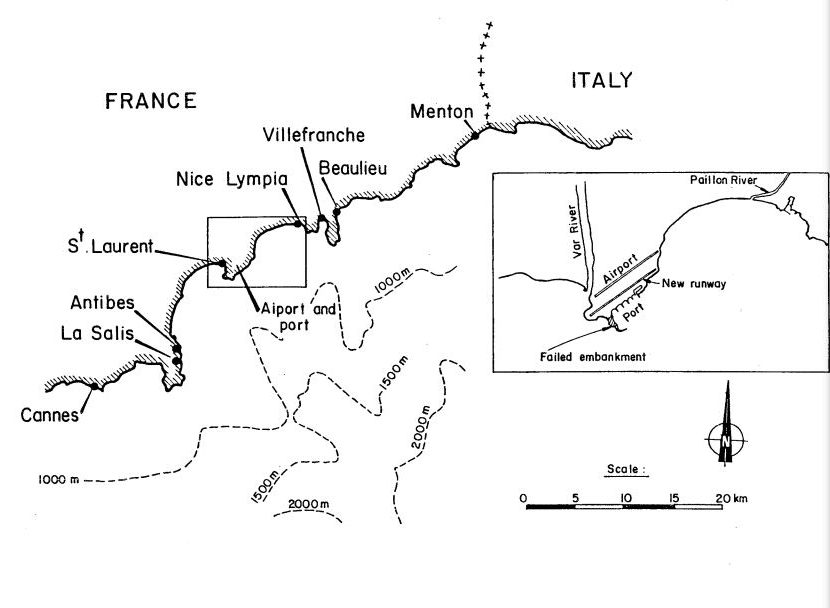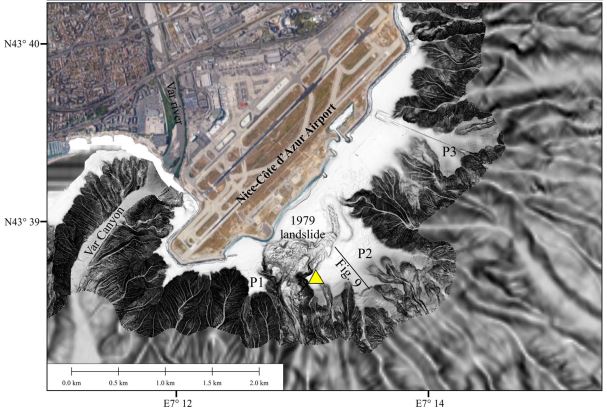4 February 2022
The 1979 Nice Airport landslide and tsunami
Posted by Dave Petley
The 1979 Nice Airport landslide and tsunami
On 16 October 1979 a significant tsunami hit the coast of southern France close to Nice, between the border with Italy and the town of Antibes. In places the waves reached 3.5 m in height and travelled up to 150 m inland. Casualty figures are unclear, but estimates range between 8 and 23 fatalities.
At Nice airport, a section of fill slope failed during this event, killing seven people. This landslide involved between 2 and 3 million cubic metres of fill that was being emplaced for the new port of Nice, but also involved about 7 million cubic metres of the underlying clay-silt, giving a total volume of 10 million cubic metres. The diagram below, from Seed et al. (1988) provides details of the location:-

The location of the 1979 Nice airport landslide. Note the section of coast that was affected by the tsunami, which extended from Antibes to the Italian border. Image from Seed et al. (1988).
.
In the hours following the disaster, two submarine cables were severed offshore from the French coast. One cable was cut after 3 hours and 45 minutes after the failure at Nice airport, and was located about 85 km from the site, whilst the other was cut 8 hours after the failure, 114 km from the slide area. These severed cables clearly indicated that there had been a massive submarine landslide, which was linked to the tsunami. No seismic event had been recorded. Subsequently, a very large submarine landslide deposit has been mapped; this is estimated to have a volume of 150 million cubic metres.
In the aftermath of the disaster, two theories emerged as to the sequence of events. In one hypothesis, the landslide at Nice airport entered a submarine canyon located offshore, triggering the much larger submarine landslide. The canyon is visible in the image below:-

The sea floor topography offshore Nice airport. The location of the 1979 landslide is shown, as is the submarine canyon. Image from Courboulex et al. (2020).
.
In the second hypothesis, the submarine landslide initiated naturally, triggering a tsunami. This in turn triggered the failure of the fill at Nice airport.
Intuitively, based on our current understanding of these events, the former hypothesis seems more credible to me. Interestingly, a review of the event a few years later (Seed et al. 1988) concluded that the most likely explanation was the second hypothesis, that the large scale submarine landslide occurred first.
However, more recent investigations have reversed that finding, determining with confidence that the first event was the failure at Nice airport (Dan et al. 2007). Critically, those responsible for the construction of the fill area had failed to appreciate the presence of a sensitive clay layer in the underlying sediments. In the days leading up to the disaster, heavy rainfall drove seepage of fresh water into the sediments, probably triggering failure in this weak layer, initiating the sequence of events.
Many lessons were learnt from this event. Perhaps most importantly, signs of distress were observed in the fill in the days prior to the collapse, including the development of cracks, settlement and embankment failures. Such warning signs should not be ignored.
.
References
Courboulex, F., Mercerat, E., Deschamps, A. et al. 2020. Strong Site Effect Revealed by a New Broadband Seismometer on the Continental Shelf Offshore Nice Airport (Southeastern France). Pure and Applied Geophysics, 177, 3205–3224.
Dan, G., Sultan, N., Savoye, B. 2007. The 1979 Nice harbour catastrophe revisited: trigger mechanism inferred from geotechnical measurements and numerical modelling.
Marine Geology 245 (1-4), 40-64.
Seed, H., Seed, R., Schlosser, F. et al. 1988. The landslide at the Port of Nice on October 16, 1979. College of Engineering, University of California.


 Dave Petley is the Vice-Chancellor of the University of Hull in the United Kingdom. His blog provides commentary and analysis of landslide events occurring worldwide, including the landslides themselves, latest research, and conferences and meetings.
Dave Petley is the Vice-Chancellor of the University of Hull in the United Kingdom. His blog provides commentary and analysis of landslide events occurring worldwide, including the landslides themselves, latest research, and conferences and meetings.
Do you know if this sensitive clay layer was above sea level, or below? Wouldn’t have expected that clays below sea level would exhibit this behaviour, so that’s very interesting if that’s the case. Thanks for sharing this project.
[Below I think. D.]
Earlier in the year, on 25 July 1979 the French also dropped a piece of the Mururoa atoll under the sea during an atomic experiment.
A local tsunami caused some damage and several injuries.
I do not have access to this document:
https://www.researchgate.net/publication/312026862_The_1979_Submarine_Landslide-Generated_Tsunami_in_Mururoa_French_Polynesia
there is also this old article in French.
https://www.geotechnique-journal.org/articles/geotech/pdf/1997/01/geotech1997078p3.pdf